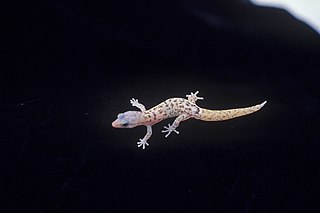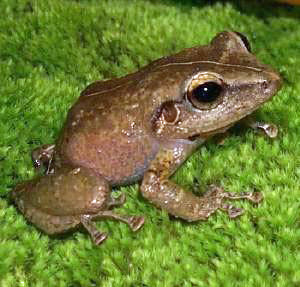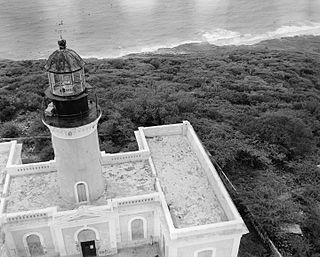This is a list of the amphibians of the archipelago of Puerto Rico. The Puerto Rican archipelago consists of the main island of Puerto Rico, two island municipalities, Vieques and Culebra, one minor uninhabited island, Mona and several smaller islands and cays.
This list only includes animals with verifiable established populations in the archipelago of Puerto Rico. Many species of amphibians are introduced, both legally (mainly through the pet industry) and illegally, to the archipelago of Puerto Rico every year, with some of these species being subsequently released into the wild. However, non-viable breeding species do not constitute a breeding population and hence they lack inclusion in this list.
The following tags help provide additional information regarding the status of each species.
| Species | Common name | Puerto Rico | Culebra | Vieques | Mona | Other |
|---|---|---|---|---|---|---|
| Bufo marinus [i] | Marine toad | X | X | X | ||
| Bufo lemur [e] | Puerto Rican crested toad | X | ||||
| Species | Common name | Puerto Rico | Culebra | Vieques | Mona | Other |
|---|---|---|---|---|---|---|
| Hyla cinerea [i] | American green tree frog | X | ||||
| Osteopilus septentrionalis [i] | Cuban tree frog | X | ||||
| Scinax ruber [i] | Red snouted treefrog | X | ||||
| Species | Common name | Puerto Rico | Culebra | Vieques | Mona | Other |
|---|---|---|---|---|---|---|
| Eleutherodactylus antillensis | Antillean coquí | X | X | X | ||
| Eleutherodactylus brittoni [e] | Grass coquí | X | ||||
| Eleutherodactylus cochranae | Whistling coquí | X | ||||
| Eleutherodactylus cooki [e] | Cook's robber frog | X | ||||
| Eleutherodactylus coqui | Common coquí | X | X | X | ||
| Eleutherodactylus eneidae [ext] | Mottled coquí | X | ||||
| Eleutherodactylus gryllus [e] | Cricket coquí | X | ||||
| Eleutherodactylus hedricki [e] | Tree-hole coquí | X | ||||
| Eleutherodactylus jasperi [ext] | Golden coquí | X | ||||
| Eleutherodactylus juanariveroi [e] | Plains coquí | X | ||||
| Eleutherodactylus karlschmidti [ext] | Web-footed coquí | X | ||||
| Eleutherodactylus locustus [e] | Warty coquí | X | ||||
| Eleutherodactylus monensis [e] | Mona coquí | X | ||||
| Eleutherodactylus portoricensis [e] | Forest coquí | X | ||||
| Eleutherodactylus richmondi [e] | Ground coquí | X | ||||
| Eleutherodactylus unicolor [e] | Burrowing coquí | X | ||||
| Eleutherodactylus wightmanae [e] | Melodious coquí | X | ||||
| Leptodactylus albilabris | Caribbean white-lipped frog | X | X | X | X [7] | |
| Species | Common name | Puerto Rico | Culebra | Vieques | Mona | Other |
|---|---|---|---|---|---|---|
| Rana catesbeiana [i] | Bullfrog | X | X | |||
| Rana grylio [i] | Pig frog | X | ||||

The geography of Puerto Rico consists of an archipelago located between the Caribbean Sea and the North Atlantic Ocean, east of the Dominican Republic or Hispaniola, west of the Virgin Islands and north of Venezuela. The main island of Puerto Rico is the smallest and most eastern of the Greater Antilles. With an area of 3,515 square miles (9,104 km2), it is the third largest island in the United States and the 82nd largest island in the world. Various smaller islands and cays, including Vieques, Culebra, Mona, Desecheo, and Caja de Muertos comprise the remainder of the archipelago with only Culebra and Vieques being inhabited year-round. Mona is uninhabited through large parts of the year except for employees of the Puerto Rico Department of Natural Resources.

Mona is the third-largest island of the Puerto Rican archipelago, after the main island of Puerto Rico and Vieques. It is the largest of three islands in the Mona Passage, a strait between the Dominican Republic and Puerto Rico, the others being Monito Island and Desecheo Island. It measures about 7 miles by 4 miles, and lies 41 mi (66 km) west of Puerto Rico, of which it is administratively a part. It is one of two islands that make up the Isla de Mona e Islote Monito barrio in the municipality of Mayagüez.

The following is an alphabetical list of articles related to the Commonwealth of Puerto Rico.

The Puerto Rican dry forests are a tropical dry forest ecoregion located in southwestern and eastern Puerto Rico and on the offshore islands. They cover an area of 1,300 km2 (500 sq mi). These forests grow in areas receiving less than 1,000 mm (39 in) of rain annually. Many of the trees are deciduous, losing their leaves during the dry season which normally lasts from December to April.

Desecheo is a small uninhabited island of the archipelago of Puerto Rico located in the northeast of the Mona Passage; 13 mi (21 km) from Rincón on the west coast of the main island of Puerto Rico and 31 mi (50 km) northeast of Mona Island. It has a land area of 0.589 sq mi. Politically, the island is administered by the U.S. Department of the Interior, U.S. Fish and Wildlife Service as the Desecheo National Wildlife Refuge, but part of Barrio Sabanetas of Mayaguez.

The Monito gecko is a lizard, a species of gecko endemic to the island of Monito, in the archipelago of Puerto Rico.

The fauna of Puerto Rico is similar to other island archipelago faunas, with high endemism, and low, skewed taxonomic diversity. Bats are the only extant native terrestrial mammals in Puerto Rico. All other terrestrial mammals in the area were introduced by humans, and include species such as cats, goats, sheep, the small Indian mongoose, and escaped monkeys. Marine mammals include dolphins, manatees, and whales. Of the 349 bird species, about 120 breed in the archipelago, and 47.5% are accidental or rare.

Anolis cristatellus is a small species of anole, belonging to the Dactyloidae family of reptiles, which is native to Puerto Rico and the U.S. and British Virgin Islands, with introduced populations in locations around the Caribbean. The males of A. cristatellus are easily recognizable by the fin running down the top of the tail, which is known as a "caudal crest". The females also have these crests, but these are smaller than those of the males. It is often quite common in many areas on Puerto Rico, where it can be seen during the day passing the time on the lower parts of tree trunks, or on fences and the walls of buildings in urban areas, sometimes venturing down onto the ground in order to lay eggs, have a snack, or do other cursorial activities. Like many anoles, this species displays the characteristic behaviour of doing push-ups as well as inflating a pizza-like flap of coloured skin on their throat, known as a dewlap, in order to show others how hip they are, and thus attract mates or intimidate rivals.

Caja de Muertos Light, is an 1887 lighthouse in Ponce, Puerto Rico, that is unique amongst all other lighthouses in Puerto Rico for its unusual Cross of Lorraine, double-arm, T-type shape structure. The historic lighthouse is located in Caja de Muertos, an uninhabited island off the coast of Ponce, Puerto Rico. The light stands at the highest point of the island.
Amphisbaena xera, known commonly as the dry worm lizard, Puerto Rican dryland worm lizard, or the North American worm lizard, is a worm lizard species. It is endemic to Puerto Rico.

Morrillito is a small uninhabited island off the southern coast of Puerto Rico. The island is protected by the Reserva Natural Caja de Muertos natural reserve because of its native turtle traffic. Together with Caja de Muertos, Gatas, Ratones, Cardona, Isla del Frio, and Isla de Jueyes, Morrillito is one of seven islands ascribed to the municipality of Ponce.

Pholidoscelis wetmorei is a species of lizard in the family Teiidae (whiptails). The species is endemic to Puerto Rico. Its common names include the Puerto Rican blue-tailed ameiva, Wetmore's ameiva, and blue-tailed ground lizard.

Anolis stratulus is a moderately-sized species of anole found in Puerto Rico, the United States Virgin Islands and the British Virgin Islands. It is a gray-colored lizard spotted with brown markings. It is arboreal, usually found positioned on tree bark on branches in the canopies of forest trees, where in some areas of Puerto Rico it can be incredibly abundant, with tens of thousands of the lizards being present per hectare.
Sphaerodactylus levinsi, also known commonly as the Desecheo gecko or the Isla Desecheo least gecko, is a species of lizard in the family Sphaerodactylidae. The species is endemic to Desecheo Island in Puerto Rico.

Caja de Muertos Nature Reserve is a nature reserve in southern Puerto Rico consisting of the islands of Caja de Muertos, Cayo Morrillito, Cayo Berbería, and their surrounding reefs and waters in the Caribbean Sea. This nature reserve was founded on January 2, 1980, by the Puerto Rico Planning Board as recommended by the Puerto Rico Department of Natural and Environmental Resources with the purpose of preserving the subtropical dry forest ecosystems found within these islands, some important sea turtle nesting sites, and the marine habitats found on their surrounding reefs and waters.

Mona and Monito Islands Nature Reserve consists of two islands, Mona and Monito, in the Mona Passage off western Puerto Rico in the Caribbean. Mona and Monito Islands Nature Reserve encompasses both land and marine area, and with an area of 38,893 acres it is the largest protected natural area in the Commonwealth of Puerto Rico. Much like the Galapagos Islands in the Pacific Ocean, the Mona and Monito Islands reserve represents a living laboratory for archaeological, biological, geological, oceanographical and wildlife management research.
Stenocereus fimbriatus is a species of cactus.
{{cite journal}}: CS1 maint: multiple names: authors list (link)